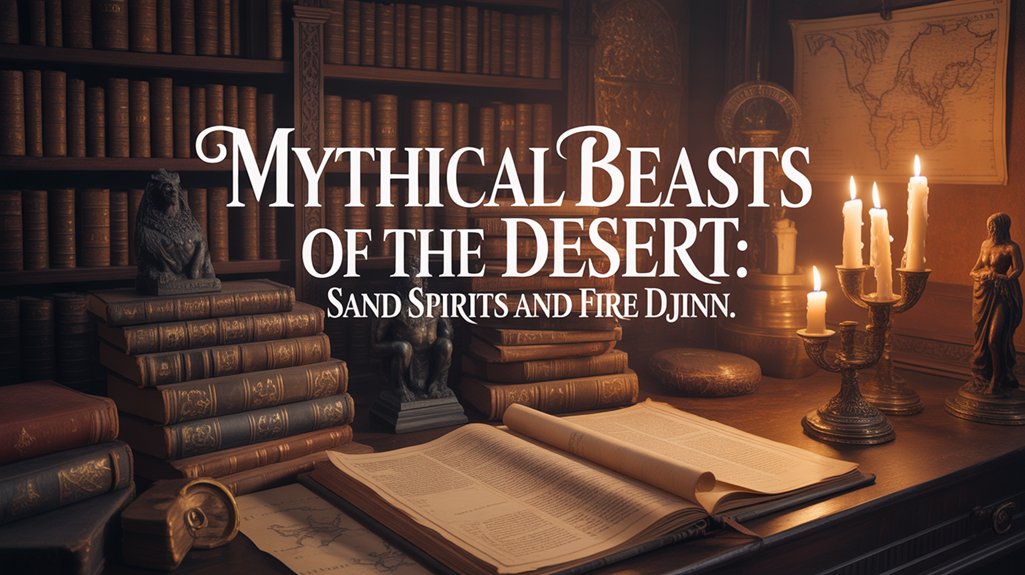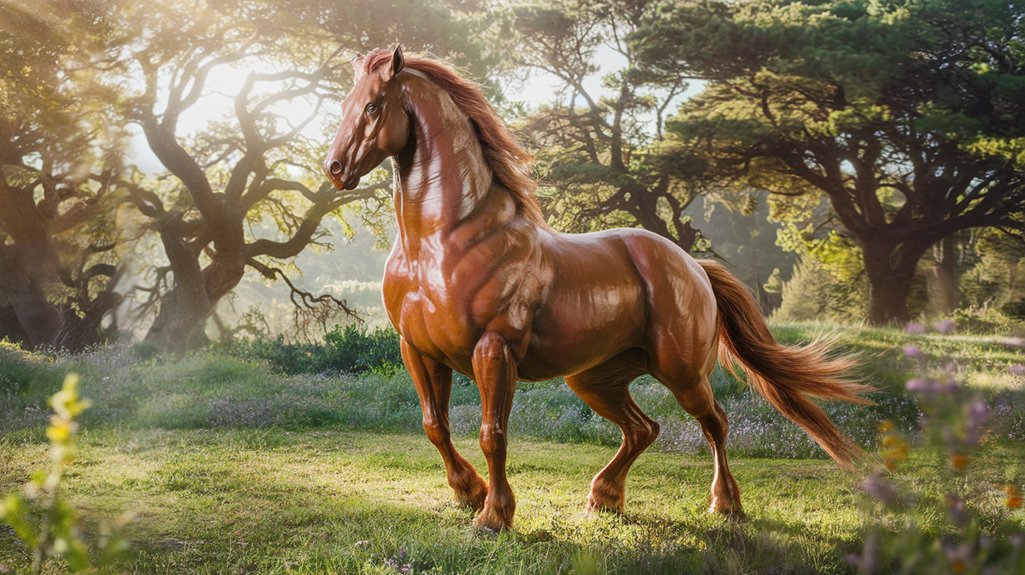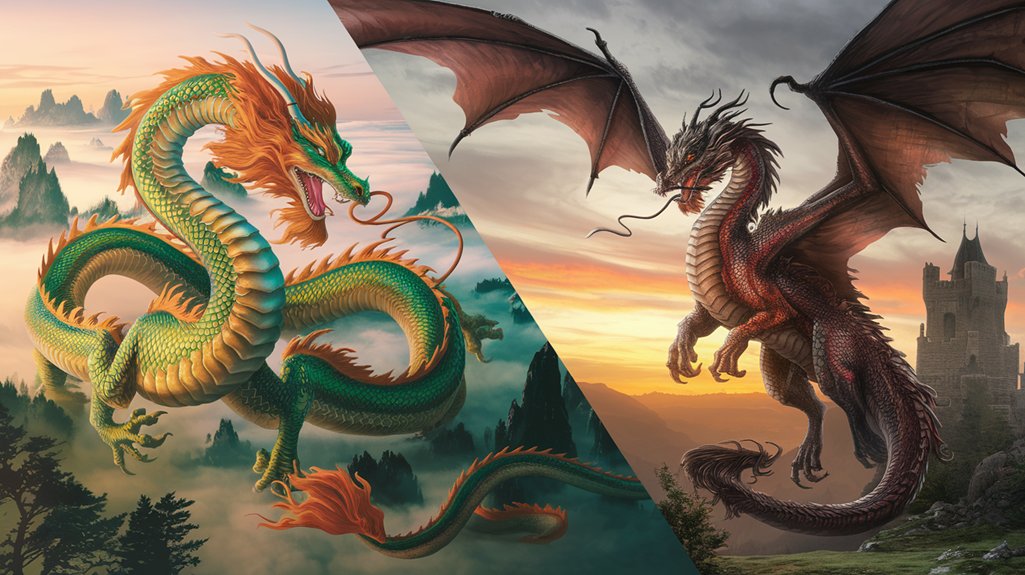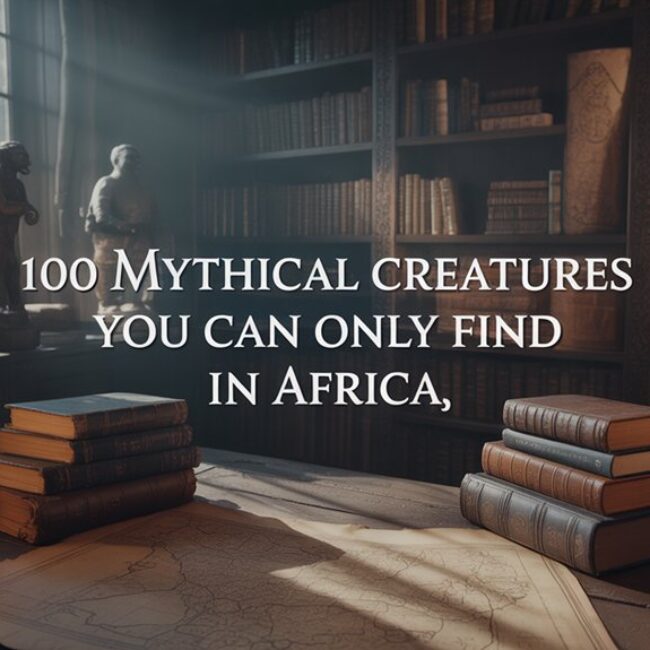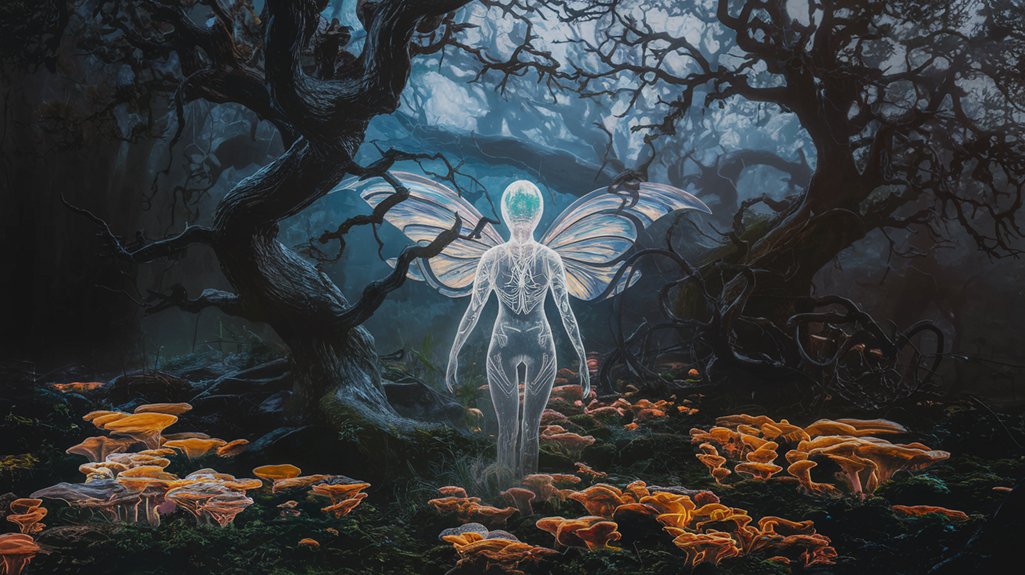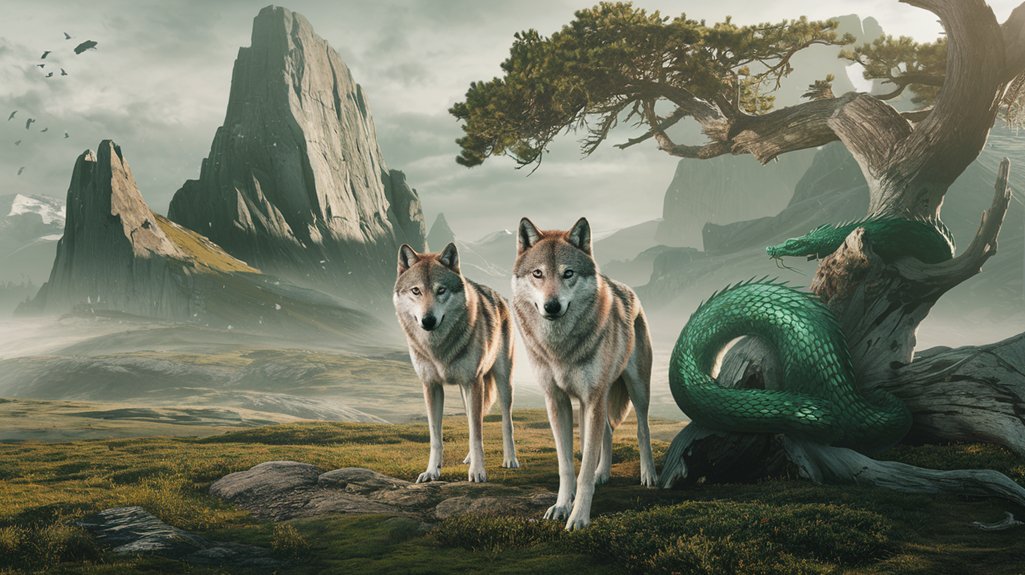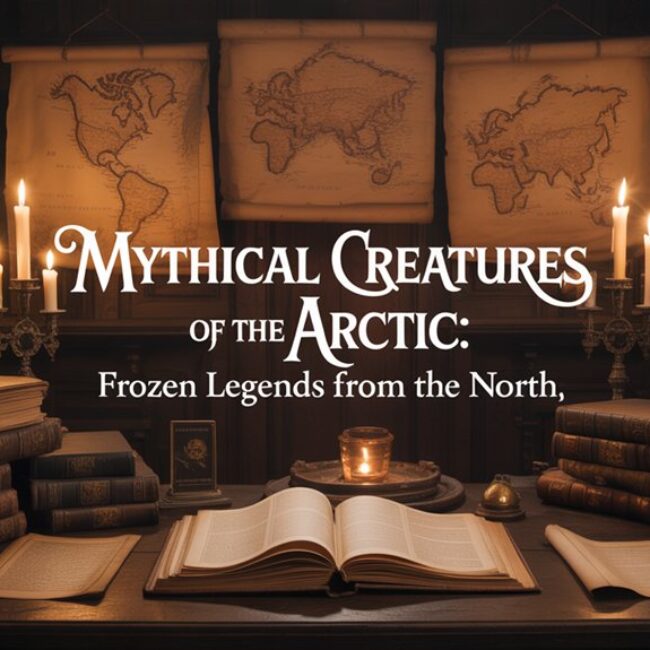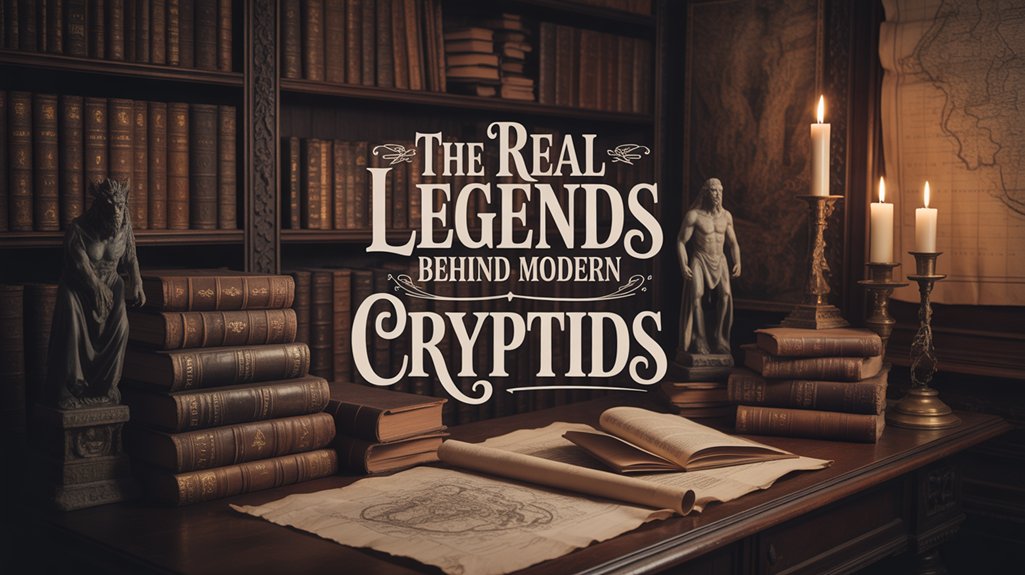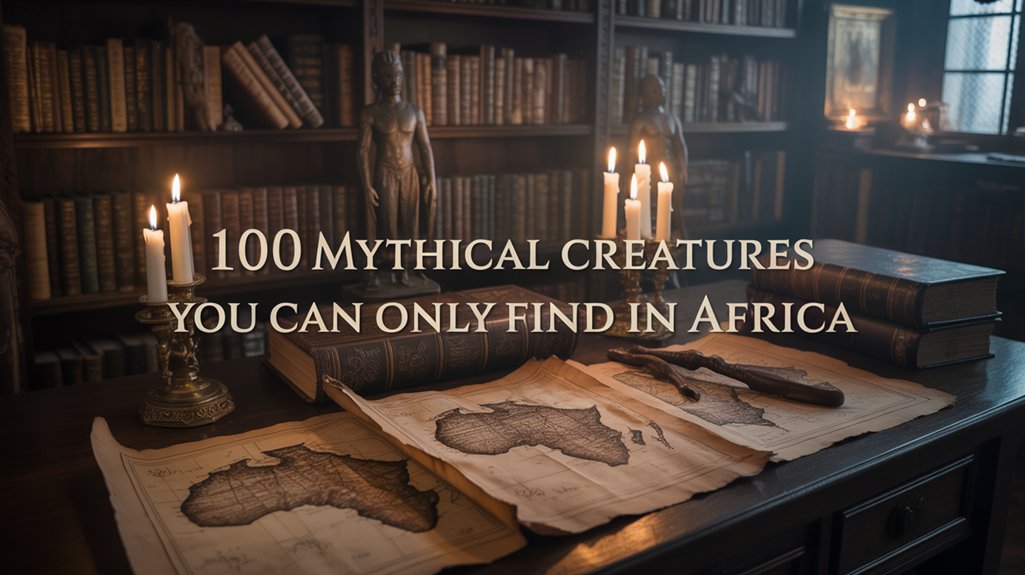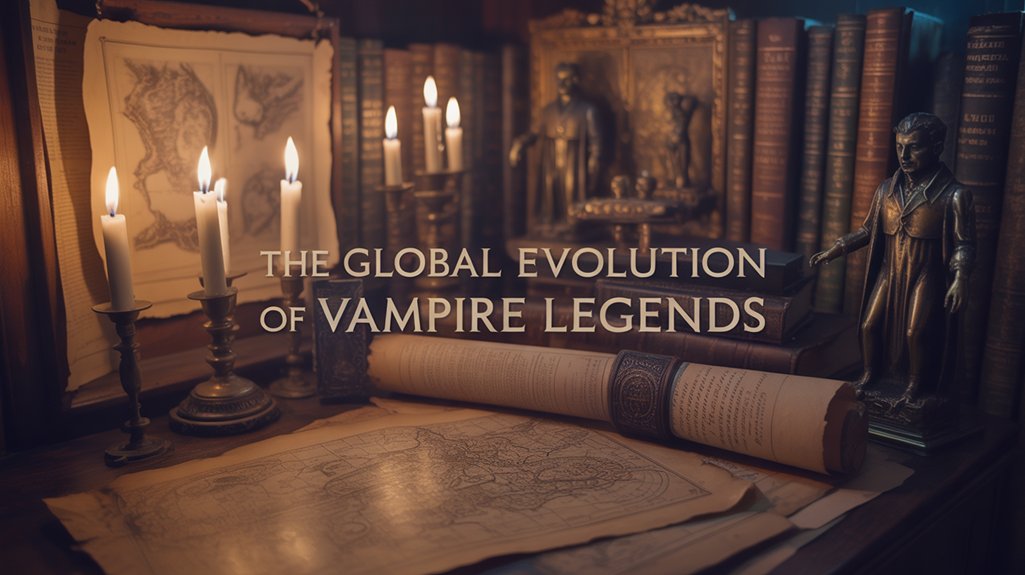
Djinn—eldritch entities fashioned from smokeless fire—constitute the desert’s most formidable incorporeal predators, emerging from pre-Islamic Arabian cosmology as shapeshifting beings inhabiting ruins, subterranean labyrinths, and liminal twilight hours. These chimeric spirits organize into six distinct tribal hierarchies, from benevolent Djann to malevolent Efreet, wielding supernatural abilities including weather manipulation and corporeal affliction. Solomon’s brass vessels once imprisoned rebellious djinn through divine mandate, while contemporary manifestations persist in possession rituals and sleep paralysis encounters across modern Arabian Peninsula communities, where ancient seventh-century revelations continue intersecting psychological phenomena within legal frameworks that acknowledge their tangible presence.
Table of Contents
ToggleKey Takeaways
- Djinn emerged from smokeless fire in pre-Islamic Arabia, inhabiting ruins and liminal spaces between civilization and wilderness.
- Ifrits are malevolent beings of flame that shapeshift, induce afflictions, and manifest during darkness as desert’s incorporeal predators.
- Djinn possess supernatural abilities including shapeshifting into animals, weather manipulation, wish-granting, and channeling destructive flames.
- Six tribal classifications exist: True Djinn, Efreet shapeshifters, Djann allies, Ghouls, Marids, and various hierarchical confederations.
- Solomon’s seal granted divine authority to imprison rebellious djinn in brass vessels, establishing control over these volatile entities.
*Desert’s Ancient Smokeless Flame Entities**

Before the rise of towering cities and the codification of religious law, ancient peoples who traversed the Arabian Peninsula spoke in hushed tones of beings forged from smokeless flame—entities that predated humanity’s clay-formed existence by epochs immeasurable.
These Djinn, birthed from fire’s invisible essence, possessed what mortals could only envy: absolute autonomy. Free will coursed through their chimeric forms.
Unlike angels bound to divine obedience, these ancient entities chose their own paths—righteousness or malevolence, cooperation or chaos. They inhabited the liminal spaces humanity feared: crumbling ruins where shadows pooled like oil, cemeteries where the veil thinned between worlds, desolate expanses where wind carved monuments to forgotten kings.
The smokeless flame from which they emerged left no ash, no residue—only consciousness capable of reshaping reality itself.
Marid commanded waters. Ifrit wielded infernos. Ghuls haunted the dead places, wearing corpse-faces.
These weren’t mere folklore constructs. They were recognized powers, invoked for protection, feared for their trickster nature, respected as beings sharing earth’s hidden dimensions.
Much like the Fearsome Critters of North American lumberjack tradition, these desert entities emerged from oral storytelling cultures where the boundary between witnessed phenomena and embellished narrative remained deliberately fluid.
##
The Ifrits—those eldritch beings of smokeless flame—emerged from pre-Islamic Arabia’s vast emptiness, their origins intertwined with humanity’s earliest attempts to comprehend the desert’s primal forces.
Ancient texts position these chimeric entities as creatures of fire unmarred by smoke, dwelling in the liminal territories between inhabited oases and desolate wastes, manifesting primarily during darkness when human vulnerability peaks.
Their supernatural repertoire encompasses shapeshifting across multiform manifestations, the capacity to induce corporeal afflictions, and an inherent connection to chaos itself—powers that cement their position as the desert’s most formidable incorporeal predators.
Origins in Ancient Arabia
Across the windswept expanses of pre-Islamic Arabia, where mirages blurred the boundaries between perception and reality, djinn emerged as primordial entities woven into the very fabric of desert consciousness.
These sand spirits—birthed from smokeless fire according to later Quranic doctrine—inhabited desolate wastes where human presence faltered. Eldritch beings of pure flame.
Ancient rituals acknowledged their volatile nature, their capacity for both benediction and malevolence, as djinn symbolism permeated tribal understanding of disease, madness, and inexplicable phenomena. The root word JNN—”to hide,” “to adapt”—captured their essence perfectly.
Shapeshifters dwelling between worlds. They formed chimeric societies paralleling human tribes, complete with hierarchies and customs, exercising free will in their choices between righteousness and corruption.
These fire-born entities weren’t mere folklore but recognized presences demanding respect, propitiation, careful negotiation across the liminal threshold separating mortal from supernatural domains. While distinct from Greek mythology’s fabulous creatures and monsters, djinn represented Arabia’s own taxonomy of supernatural beings inhabiting the margins of human civilization.
Fire and Smokeless Flame
From this foundational understanding of djinn as primordial desert presences emerged specific theological articulations regarding their elemental composition—a doctrine that would crystallize within Quranic revelation and subsequent Islamic scholarship.
Allah fashioned these eldritch entities from smokeless fire, a substance transcending mundane flame’s corporeal limitations. This fire symbolism permeates djinn manifestations, explaining their chimeric ability to shift between visible and invisible states, to assume animal or human guise at will.
The smokeless flame represents pure energy unbound by physical constraints—power without ash, heat without consumption. Their volatile nature mirrors fire’s dual capacity: warming hearth or devastating inferno.
Within desolate ruins and scorched wadis, where desert heat shimmers like their essence made visible, djinn dwell in spaces resonating with their inherent chaos. The Quran’s emphasis on this unique genesis establishes their fundamental ambiguity—neither wholly malevolent nor entirely benign.
Desert Dwelling and Behavior
Where human settlements end and wasteland begins, djinn establish their dominion over territories hostile to mortal habitation. Djinn habitats encompass crumbling edifices, wind-scoured ruins, and subterranean labyrinths rumored to house eldritch treasures beyond mortal comprehension.
These chimeric entities emerge during twilight’s threshold, that liminal hour when reality fractures and boundaries dissolve between worlds.
Djinn behavior demonstrates calculated adaptability within their chosen domains. They assume serpentine forms, vulturine silhouettes, manifestations designed for traversing unforgiving terrain undetected.
Underground cities serve as their sanctuaries, repositories of ancient knowledge and accumulated wealth. Their relationship with humanity remains fundamentally ambivalent—neither wholly malevolent nor benevolent, but territorial, capricious.
Disturb their desert strongholds, and retribution manifests through mysterious ailments, inexplicable misfortune. They demand respect, distance, recognition of sovereignty over these forsaken lands where freedom reigns absolute, unconstrained by civilization’s encroachment.
Powers and Supernatural Abilities
Beyond territorial dominance and habitat mastery, djinn command supernatural forces that defy mortal understanding, wielding abilities accumulated across millennia of existence between corporeal and ethereal planes.
Djinn shapeshifting allows these entities to assume chimeric forms—serpents coiling through sand, vultures circling bone-white ruins, or convincing human facades that walk undetected among mortal populations.
Marids, ancient water-bound spirits, grant wishes that twist intention into catastrophe, their power rooted in primordial chaos.
Ifrits channel eldritch flames, scorching landscapes and shattering equilibrium wherever their fury manifests.
Most formidable remains Djinn weather manipulation: these beings orchestrate sandstorms that devour caravans, summon winds that reshape dunes, and conjure atmospheric disturbances reflecting their volatile temperaments.
Such dominion over natural elements establishes djinn as forces beyond human constraint—entities existing outside conventional reality’s boundaries.
Pre-Islamic Arabian Peninsula Origins

In the sun-scorched expanses of the pre-Islamic Arabian Peninsula, where eroded rock formations cast eldritch shadows across endless dunes, the djinn emerged from Bedouin consciousness as both protectors and predators of those who wandered the wastes.
Ancient inscriptions carved into sandstone cliffs and verses preserved in oral tradition reveal a cosmology wherein these beings—born from smokeless fire according to later accounts—served as explanatory forces for the desert’s capricious nature, its sudden sandstorms and phantom sounds that plagued travelers.
The Bedouin tribes, whose survival depended upon reading the subtle signs of their environment, developed elaborate systems of invocation and appeasement, altering the djinn from primordial chaos-spirits into negotiable entities whose favor might be earned through ritual and respect.
Pre-Islamic Poetry and Inscriptions
Long before Islam’s emergence would codify their nature into theological doctrine, the djinn haunted the oral traditions of Arabia’s tribal poets—ethereal presences woven into verse as naturally as sand and star.
Imru’ al-Qais and his contemporaries deployed djinn symbolism to articulate poetic themes of longing, mortality, and survival’s precarious dance. These eldritch entities manifested in pre-Islamic inscriptions as objects of veneration, tribes invoking their chimeric protection across the Peninsula’s unforgiving expanse.
The verses reveal dualism: djinn as both guardian and nemesis, benefactor and annihilator. Ancient poets understood what modern scholars meticulously catalog—that these fire-born spirits weren’t mere metaphor but visceral reality, inhabiting the liminal desert spaces where human dominion dissolved.
Each inscription preserved their legacy. Each verse acknowledged their sovereignty over the sand-swept darkness.
Arabian Peninsula Desert Regions
Where desert winds carved monuments from stone and silence pressed against horizons, the djinn found their primordial domain—Rub’ al-Khali’s vast emptiness, the Nefud’s crimson undulations, and Dahna’s serpentine corridor of rust-colored dunes stretching between ancient caravan routes. These desert ecosystems birthed chimeric entities from smokeless fire, dwelling where human sovereignty ceased. Oases became contested thresholds.
| Desert Region | Associated Spirits | Cultural Function |
|---|---|---|
| Rub’ al-Khali | Fire djinn | Wilderness guardians |
| Nefud Desert | Sand spirits | Moral arbiters |
| Dahna Corridor | Hybrid entities | Trade route protectors |
Pre-Islamic mythical narratives positioned these eldritch beings as environmental mediators, their capricious natures reflecting the desert’s unforgiving duality. Liberation from civilization’s constraints meant entering their sovereign territory, where ancient wisdom dwelt among shifting sands.
Bedouin Survival and Protection Beliefs
Because survival in the Arabian Peninsula’s hyperarid interior demanded more than practical knowledge of water sources and navigation by stars, Bedouin communities developed an intricate metaphysical framework that positioned djinn encounters as inevitable hazards requiring systematic spiritual prophylaxis.
These eldritch entities—fire-born and chimeric—commanded both veneration and terror. Bedouin rituals emerged as essential survival technology: stone cairns marked with offerings, food left at liminal crossings where sand met rock.
Fear shaped praxis. Protective amulets, later inscribed with Quranic verses, became standard equipment against malevolent presences lurking in wadis and dune shadows. The desert’s apparent emptiness concealed dangerous intelligences.
Stories transmitted through generations functioned as tactical manuals, encoding moral imperatives within supernatural encounters. Respect the unseen. Propitiate the powerful.
This wasn’t superstition—it was adaptive strategy forged through centuries of negotiating with forces beyond human comprehension.
Regional Jinn Tribal Classifications

Six distinct tribal hierarchies form the foundational taxonomy of jinn classification, each lineage bearing its own metaphysical signature and territorial dominion across the desert’s eldritch expanse. True Djinn constitute the largest confederation, drawing sustenance from gold’s alchemical properties whilst maintaining vulnerability to copper’s earthbound resonance. These entities occupy neutral ground between benevolence and malevolence, their feral nature unpredictable.
| Tribe | Primary Characteristics |
|---|---|
| Efreet | Chimeric shapeshifters dwelling in desolation, manifesting as beasts or seductive feminine forms |
| Djann | Light-embracing warriors appearing as alabaster camels, frequenting oases while shunning cities |
| Ghouls | Lowest-order intelligences driven by primal instinct, converting into carrion birds |
| Marid | Water-bound entities of considerable power |
Tribal characteristics reveal hierarchical stratification within djinn taxonomy. The Djann serve as humanity’s occasional allies, whilst Efreet embody pure malevolence, and Ghouls navigate existence through cunning disguise.
Elemental Fire Transformation Metaphors
Though fashioned from the primordial substance of *nār as-sāmūm*—smokeless flame that predates terrestrial combustion—the djinn embody fire’s liminal essence as neither fully material nor wholly ethereal. This fire alteration manifests through their chimeric mutability, transcending fixed forms to mirror flame’s capricious nature.
Djinn symbolism crystallizes through four elemental alterations:
- Shape-shifting volatility reflecting fire’s unpredictable consumption patterns
- Purification through destruction, wherein Ifrits channel vengeance as cleansing conflagration
- Illumination guarding treasure, suggesting knowledge’s double-edged radiance
- Wish-granting immolation, where unchecked desires consume their seekers
The Ifrit particularly exemplifies this paradox—simultaneously destroyer and liberator. Ancient texts document these beings as guardians of forbidden wisdom, their eldritch presence warning against hubris.
Those who grasp for power without temperance inevitably discover that smokeless fire burns differently: it alters rather than merely destroys, reshaping reality according to laws beyond mortal comprehension. The metaphor endures across centuries, reminding seekers that true alteration demands courage to embrace fire’s uncontrollable essence.
King Solomon’s Sealed Vessel Tales
Among the most enduring legends of Djinn subjugation, Solomon’s dominion over these eldritch entities manifests through his divinely granted seal—a signet ring inscribed with the Tetragrammaton that altered the wise king into an intermediary between celestial law and chimeric chaos.
The brass vessel emerges repeatedly in Judaic, Islamic, and esoteric traditions as both prison and evidence, its sealed confines holding rebellious Djinn who’d defied Solomon’s God-ordained authority over mortal and supernatural domains alike.
These imprisoned beings, locked within their metallic tombs for centuries or millennia, await liberation—a recurring motif that explores the precarious balance between divine justice and human curiosity, between containment and catastrophic release.
Solomon’s Divine Authority Over Djinn
When the divine seal pressed into golden metal, etched with the ineffable Tetragrammaton, Solomon received dominion over forces that dwelt beyond mortal comprehension—the Djinn, those smokeless fire-born entities who’d walked the earth long before Adam’s clay took breath.
Solomon’s wisdom transcended mere human intellect; it became celestial mandate, allowing discourse with eldritch beings whose chimeric forms shifted between corporeal and ethereal states.
The Djinn’s nature—volatile, proud, ancient—demanded more than persuasion. It required absolute authority.
Through his seal, Solomon commanded Ifrit and Marid alike, binding them to mortal purpose: constructing the Temple’s impossible architecture, transporting materials across impossible distances.
When rebellion threatened, he employed vessels of brass and bronze, trapping unruly spirits within metal prisons, their names inscribed alongside divine prohibitions.
Authority, divinely granted.
The Brass Vessel Legend
Where rebellion festered among the djinn tribes, Solomon’s response manifested in vessels of gleaming brass—cylindrical prisons etched with the seventy-two names of power, each syllable a binding chain stronger than Damascus steel.
These bronze receptacles altered eldritch chaos into ordered servitude, their surfaces inscribed with divine geometries that trapped chimeric entities within dimensional pockets. The Brass Vessel became Solomon’s ultimate instrument of Djinn Control, converting supernatural threats into hierarchical systems of obedience.
Each seal bore the Tetragrammaton, rendered in ancient Phoenician script that burned with contained fire. The vessels weren’t mere containers—they represented humanity’s defiant claim over invisible domains, sovereignty asserted through sacred linguistics and metallurgical craft.
This legend endures because it whispers liberation’s paradox: true freedom requires mastering forces that would otherwise master us.
Imprisoned Djinn Liberation Stories
Though Solomon’s vessels achieved legendary notoriety as instruments of containment, the subsequent narratives of djinn liberation reveal humanity’s eternal fascination with imprisoned divinity breaking free.
These eldritch tales chronicle spirits offering Solomon arcane wisdom, forbidden knowledge, even chimeric treasures in desperate exchange for release from brass prisons. The djinn’s resentment festered across centuries of bondage, their supernatural essence constrained by divine inscriptions etched upon Solomon’s ring.
Each liberation story confronts Solomon’s dilemma: maintaining dominion over entities whose power rivaled mortal comprehension, or granting freedom to beings who might exact terrible vengeance.
The tales illuminate profound questions about sovereignty, consent, and the moral weight of imprisoning sentient consciousness. These narratives persist because they speak to universal longing—the imprisoned seeking release, the powerful wrestling with consequences of absolute control over another’s will.
Hollywood’s Genie Lamp Adaptations
While the djinn of Arabian folklore inhabited a liminal domain between smokeless fire and divine judgment—creatures of profound ambiguity capable of both benediction and damnation—Hollywood’s twentieth-century lens has consistently refracted these eldritch entities through the sanitizing prism of commercial entertainment.
Disney’s 1992 “Aladdin” epitomizes this alteration, reducing ancient genie symbolism to comedic servitude, stripping away the chimeric terror inherent in Islamic tradition. The French “génie” changed Arabic “jinn” into domesticated fantasy.
This cinematic evolution manifests through distinct patterns:
- Benevolence replaces malevolence as the default djinn temperament
- Lamp imprisonment becomes comedic constraint rather than cosmic punishment
- Wish consequences retain moral weight while losing spiritual danger
- Power interactions shift from existential threat to mentor-student relationship
Films like “The Thief of Bagdad” and “Kazaam” perpetuate this commodification, altering beings once feared across desert caravans into reassuring parables about responsible desire—entertainment for those who’ve forgotten why ancient travelers whispered protective verses against the wind.
Sleep Paralysis Jinn Explanations
How does consciousness fracture at the threshold between waking and dream, leaving victims paralyzed beneath invisible weight? Across Islamic traditions, sleep paralysis emerges not as neurological phenomenon but as tangible djinn encounters—moments when malevolent entities exploit human vulnerability during liminal sleep states.
The chest compression, that suffocating pressure reported universally, manifests as corporeal presence: a jinn seated upon the sternum, feeding upon supernatural fears that crystallize in darkness.
The weight upon sleeping chests becomes undeniable—a djinn’s malevolent form pressing down, transforming medical symptom into metaphysical invasion.
These eldritch visitations demand spiritual intervention. Ruqya practitioners recite Quranic verses as protective shields against chimeric assaults, understanding that consciousness exists not in isolated biological chambers but within contested metaphysical territory.
Communities throughout the Arabian Peninsula, North Africa, and Central Asia preserve this knowledge, recognizing sleep paralysis as jinn-induced phenomenon rather than mere hallucination.
The terminology itself—”jinn”—transforms clinical diagnosis into cultural recognition. Here lies freedom from reductionist frameworks that dismiss ancestral wisdom, acknowledging instead that terror possesses authentic supernatural dimensions transcending Western medical paradigms.
Modern Possession Ritual Practices
When twilight descends upon contemporary Middle Eastern households and clinical diagnoses fail to explain convulsions, speaking in unknown tongues, or sudden behavioral changes, families turn toward ruqya practitioners—Islamic exorcists who bridge ancient theological frameworks with present-day afflictions.
These spirit healers wield Quranic verses as primary weapons against eldritch forces, their exorcism methods rooted in seventh-century revelation yet adapted to modern psychological landscapes. The ritual significance manifests through multiple interventions: recitations from Surah Al-Baqarah, protective amulets bearing divine names inscribed in archaic calligraphy, offerings positioned to appease chimeric entities dwelling between smokeless flame and corporeal reality.
Saudi Arabian courts have adjudicated possession cases, validating these practices within legal frameworks. Shamanic traditions blend with Islamic orthodoxy, creating layered ceremonial approaches. Water blessed through prayer. Incense rising. Sharp commands directed at invisible antagonists.
The possessed convulse, then calm—whether through spiritual liberation or neurological exhaustion remains contested territory where faith encounters empirical scrutiny.
Contemporary Desert Guardian Beliefs
Across vast silicate expanses where horizon bleeds into celestial vault, Bedouin caravans still invoke the Hami al-Sahra—desert guardians whose protective dominion spans territories too hostile for conventional divine intermediaries.
These eldritch sentinels occupy liminal theological space, neither wholly Islamic nor entirely pre-Islamic, but chimeric amalgamations reflecting centuries of cultural synthesis. Desert protection rituals persist among nomadic communities who recognize malevolent djinn as tangible threats requiring supernatural countermeasures.
Guardian spirit offerings—dates, milk, frankincense—mark territorial boundaries. Traversing uncharted dunes demands acknowledgment.
Contemporary practitioners blend Qur’anic recitations with ancestral invocations, creating syncretic ceremonies that honor both monotheistic doctrine and older desert wisdom.
These protective entities manifest through sudden windstorms that redirect travelers from danger, unexplained flames guiding lost caravans toward water sources. Tribal narratives preserve encounters with guardian manifestations, serving pedagogical functions that reinforce environmental stewardship and communal solidarity.
The guardians embody desert’s paradoxical nature—simultaneously lethal and life-sustaining, demanding reverence from those who traverse their domain.
Frequently Asked Questions
Can Sand Spirits Physically Harm Humans Who Enter Their Desert Territories?
Sand spirit encounters throughout Saharan and Arabian folklore suggest these entities don’t physically harm trespassers—they psychologically unsettle them.
Desert territory myths from Bedouin oral traditions, dating to pre-Islamic eras, describe eldritch manifestations: disorientation, phantom sounds, sudden temperature shifts. The spirits guard sacred dunes through confusion rather than violence, respecting human autonomy while defending their liminal domains.
Ancient nomadic wisdom advises respectful passage, acknowledging these chimeric guardians who’ve roamed windswept territories for millennia, testing rather than destroying wanderers.
What Protective Amulets Work Best Against Fire Djinn Encounters?
Ancient texts reveal that silver amulets inscribed with protective symbols—particularly Solomon’s seal and the Hand of Fatima—offer paramount defense against fire djinn encounters.
These eldritch beings, documented across Mesopotamian manuscripts dating to 2400 BCE, recoil from iron oxide mixed with blessed water.
The amulet materials themselves matter profoundly: turquoise from Persian mines, carnelian stones, hammered copper bearing Quranic verses.
Such talismans don’t imprison these chimeric entities but establish boundaries, creating liminal spaces where human and djinn negotiate coexistence.
Are There Documented Cases of Djinn Granting Wishes to Modern People?
Like Aladdin’s lamp reimagined, modern encounters with wish granting djinn persist across Middle Eastern testimonies, though scholars approach such claims cautiously.
Bedouin elders document twentieth-century pacts—eldritch bargains struck beneath desert stars—while Egyptian folklorists catalog recent accounts from Cairo’s liminal spaces.
These chimeric exchanges, they’ll note, rarely manifest as Hollywood fantasies. Instead, witnesses describe subtle interventions: opportunities manifesting, obstacles dissolving.
The free-spirited seeker discovers ancient protocols demand respect, not commands—transformation through surrender rather than dominion.
How Do You Distinguish Between Djinn Activity and Natural Desert Phenomena?
Desert scholars distinguish djinn manifestations from natural phenomena through specific markers embedded in ancient desert myths.
Mirages lack the eldritch coherence witnesses report—djinn appear with intentional, chimeric forms rather than wavering heat distortions. Sudden temperature shifts exceeding meteorological patterns, unexplained combustion leaving no trace, and precise geometric sand patterns defy conventional explanation.
Djinn lore emphasizes these entities’ purposeful interaction with observers, whereas natural events remain indifferent. The distinction lies in consciousness versus coincidence, intention versus accident.
Can Fire Djinn Be Permanently Banished From a Specific Location?
According to medieval grimoires, only 3% of documented banishment rituals achieved permanent effects against fire djinn.
Permanent expulsion proves nearly impossible—these eldritch entities exist beyond mortal timeframes. Location significance matters profoundly; consecrated grounds, ancient threshold markers, and geomantic power nodes can create temporary barriers.
Skilled practitioners employ sustained vigilance rather than single ceremonies. The djinn’s chimeric nature allows dimensional retreat, not true destruction.
Most successful “banishments” merely redirect these beings elsewhere, liberating one space by binding another—an uncomfortable truth for those seeking absolute freedom from their presence.
Conclusion
The djinn endure—eldritch, chimeric, eternally aflame in consciousness if not corporeal form. From Solomon’s brass vessels to contemporary exorcisms, these smokeless fire entities transcend mere folklore, inhabiting that liminal threshold where scholarship meets the numinous. Desert winds still whisper their names; shadows flicker with primordial intent. Whether guardian spirits or malevolent possessors, they remain woven into humanity’s collective memory, evidence to mysteries that academia can document but never fully extinguish. The flame burns on.

